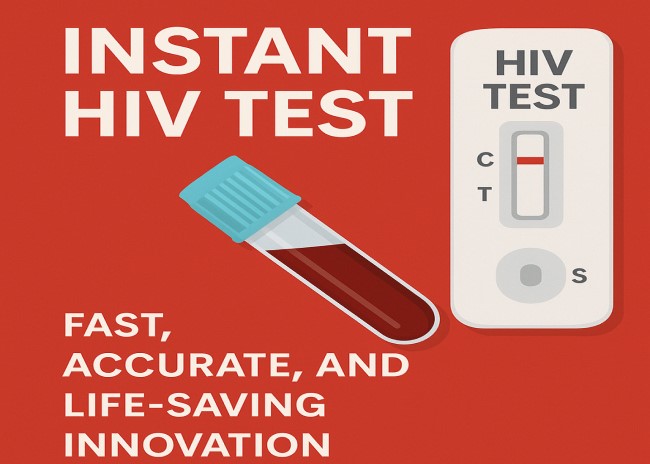Instant HIV Test: A Fast, Reliable, and Life-Saving Innovation

The instant HIV test has revolutionized the way people approach HIV detection and prevention. With fast, convenient, and accurate results available in minutes, this modern method of testing empowers individuals to know their HIV status without the long waiting periods of traditional lab tests. HIV (Human Immunodeficiency Virus) remains one of the world’s major public health challenges, but early detection through instant testing has proven to be a game-changer in reducing transmission rates and improving health outcomes.
What Is an Instant HIV Test?
An instant HIV test, also known as a rapid HIV test, is a screening method designed to detect HIV antibodies and, in some cases, antigens in a person’s body. Unlike conventional lab tests that take days or weeks, instant HIV tests can provide results within 15 to 40 minutes.
These tests typically use either:
-
Blood samples (from a finger prick)
-
Oral fluid samples (from a gum or cheek swab)
The test detects the presence of HIV antibodies—the body’s immune response to the virus—or both antibodies and p24 antigen, a protein produced soon after infection.
How Does an Instant HIV Test Work?
The Testing Process
-
Sample Collection – A small drop of blood or oral fluid is collected using a sterile testing kit.
-
Reagent Reaction – The sample is placed on a test strip or cassette containing special chemicals that react with HIV antibodies or antigens.
-
Result Display – Within 20–30 minutes, the test shows either a negative, positive, or invalid result.
Understanding the Results
-
Negative (Non-Reactive): No HIV antibodies or antigens were detected. However, this does not always mean you are HIV-free—testing during the “window period” may give false negatives.
-
Positive (Reactive): HIV antibodies or antigens were found. This result should be followed by a confirmatory laboratory test to verify infection.
-
Invalid: The test was not performed correctly or the kit was defective. Retesting is needed.
The Accuracy of Instant HIV Tests
Modern instant HIV tests are extremely reliable. Most tests have an accuracy rate above 99% when used correctly and after the window period. However, the type of test and timing of testing greatly influence accuracy.
Factors Affecting Accuracy
-
Window Period – The time between HIV exposure and the body’s production of detectable antibodies.
-
For most people, antibodies develop within 3 to 12 weeks.
-
-
Type of Sample – Blood-based tests are slightly more sensitive than oral fluid tests.
-
User Error – Incorrect sample collection or timing can affect results.
Confirmatory Testing
Even if an instant test shows a positive result, a confirmatory test such as an ELISA or Western Blot test is required. These tests are conducted in laboratories to ensure accuracy before diagnosis.
Benefits of Instant HIV Testing
Fast and Convenient
Unlike traditional tests, where you might wait days for results, the instant HIV test delivers answers in minutes. This rapid process encourages more people to get tested regularly.
Privacy and Accessibility
Many instant HIV tests are available as self-testing kits, allowing individuals to check their HIV status privately at home. This reduces stigma and increases participation among people who may be hesitant to visit clinics.
Early Detection Saves Lives
Detecting HIV early means treatment can begin sooner. Antiretroviral therapy (ART) helps control the virus, enabling individuals to live long, healthy lives and significantly reducing the risk of transmission.
Cost-Effective and Widely Available
Instant HIV tests are relatively affordable and are available at clinics, pharmacies, and through community health programs. In many countries, government and non-profit organizations offer free or low-cost testing to the public.
The Window Period: Why Timing Matters
The window period is one of the most critical concepts to understand in HIV testing. It refers to the time between exposure to HIV and the point when the body produces enough antibodies or antigens for detection.
Typical Window Periods
-
Antibody-only tests: Detect infection after 4 to 12 weeks.
-
Antigen/antibody combo tests: Can detect HIV as early as 18 to 45 days after exposure.
Testing too early might yield a false-negative result. Health professionals recommend retesting after three months if you believe you were recently exposed.
Limitations of Instant HIV Testing
While instant HIV tests are powerful tools, they are not without limitations.
False Negatives
A negative result does not always guarantee the absence of HIV infection, especially if taken during the window period. Retesting after the appropriate time frame is essential.
False Positives
Occasionally, a person might receive a positive result even though they are not infected. This is why confirmatory testing is always required after a reactive result.
User Handling Errors
Self-testing requires proper handling and adherence to instructions. Misreading results, using expired kits, or contaminating samples can lead to inaccurate outcomes.
Instant HIV Test vs. Traditional Testing
| Feature | Instant HIV Test | Traditional HIV Test |
|---|---|---|
| Result Time | 15–40 minutes | 1–2 weeks |
| Sample Type | Blood drop or oral fluid | Blood from vein |
| Location | Home or clinic | Laboratory |
| Accuracy | 99% (post-window period) | 99.9% |
| Follow-up Needed | Yes, for positive results | Usually automatic |
Instant HIV tests offer unmatched convenience and speed, but laboratory tests remain the gold standard for confirming infection.
When Should You Get Tested?
Getting tested for HIV should be a routine part of your health care, especially if you have engaged in any high-risk activities such as:
-
Unprotected sex with multiple partners
-
Sharing needles or syringes
-
Exposure to blood or bodily fluids
-
Having an HIV-positive partner
Health experts recommend that everyone aged 15–65 should get tested at least once in their lifetime, and people with higher risk factors should test every 3 to 6 months.
What to Do After Testing
If the Result Is Negative
-
Continue practicing safe sex and preventive measures.
-
Consider pre-exposure prophylaxis (PrEP) if you are at high risk.
-
Retest after the window period if your last exposure was recent.
If the Result Is Positive
-
Do not panic. A reactive result must be confirmed by a laboratory test.
-
Visit a healthcare provider immediately for confirmation and counseling.
-
If confirmed positive, start antiretroviral therapy (ART) as soon as possible. Early treatment suppresses the virus and protects your immune system.
Conclusion
The instant HIV test has transformed the global fight against HIV by making testing faster, simpler, and more accessible. Knowing your HIV status is the first step toward protection, prevention, and treatment. With just one quick test, you can take charge of your health and contribute to stopping the spread of HIV.
Regular testing, combined with safe practices and education, ensures that HIV is no longer a silent threat but a manageable condition. The sooner you test, the sooner you know—and the sooner you can live a healthier, more confident life.



